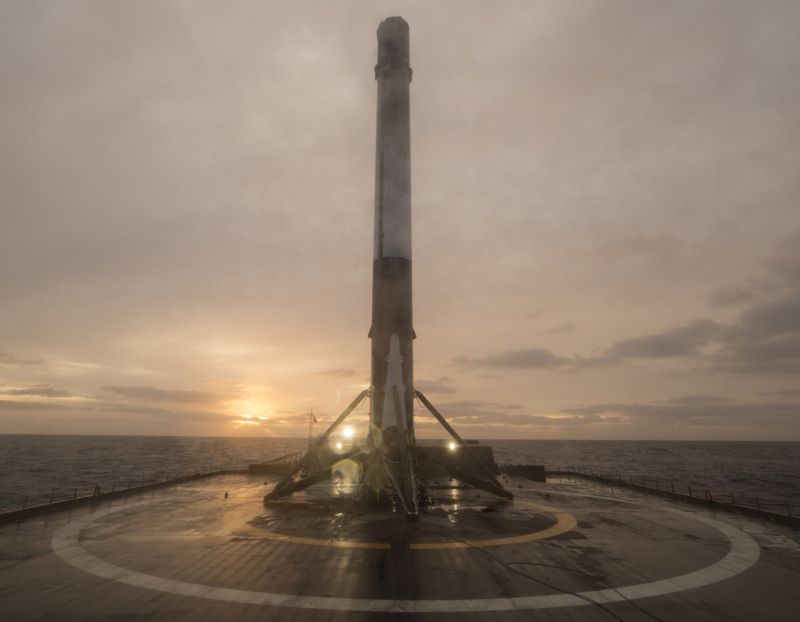
After successfully returning to flight on January 14, SpaceX will make its next launch from Cape Canaveral no earlier than January 30. With this mission from a new pad at Launch Complex 39A, SpaceX will loft the EchoStar 23 communications satellite to geostationary transfer orbit.
This is a heavy satellite, weighing 5.5 metric tons, and getting it out to about 40,000 kilometers from the surface of the Earth will require pretty much all of the lift capacity of SpaceX's Falcon 9 rocket. This would leave almost no propellant for the Falcon 9 rocket to fire its engines to slow down, make a controlled descent through the Earth's atmosphere, and attempt a difficult landing on a drone ship.
On Saturday, in response to a question on Twitter, SpaceX founder and chief executive Elon Musk confirmed that the upcoming EchoStar launch will therefore indeed be expendable. "Future flights will go on Falcon Heavy or the upgraded Falcon 9," he added.
In other words, in the future such heavy payloads will either be launched on the more powerful Falcon Heavy (consisting of three Falcon 9 cores, designed for return), or a slightly more powerful variant of the Falcon 9 rocket. Although SpaceX may launch one or two more expendable rockets, Musk is saying the plan here onward is to try and launch everything on reusable boosters.
Falcon 9, Block 5
A few minutes later, Musk elaborated on the "upgraded Falcon 9" rocket, saying the "Block 5 is the final upgrade of the Falcon architecture. Significantly improves performance & ease of reusability. Flies end of year." Within this comment there are some important tidbits in here about the final version of the company's workhorse Falcon 9 rocket.
In many ways SpaceX has acted more like a startup company than a traditional aerospace company, and as such it has constantly been tinkering with the design of the Falcon 9, seeking to improve its performance. Unofficially, there have been at least four versions of the Falcon 9 booster—the Falcon 9 v1.0, Falcon 9 v1.1, Falcon 9R v1.1, and Falcon 9 Full Thrust. First flown in December, 2015, this last variant included and updated Merlin-1D rocket engine and used chilled, densified propellant. Combined, the rocket and propellant add about 30 percent to the lift performance of the previous Falcon 9.
But now SpaceX appears to be close to maximizing performance of the Falcon 9 rocket. Musk confirmed that SpaceX will make one more major improvement to its Falcon 9 rocket, which he's calling "Block 5." In a Reddit AMA in late 2016, he provided a little bit more information about this Block 5 version, saying it will increase performance (enough, such that a launch like EchoStar 23 could attempt a landing) and be designed for easy reuse.
Easy reuse?
The latter point is potentially significant, given that in the near term one of SpaceX's primary goals is to simplify the reuse of its rockets. With seven first-stage booster landings at sea and on land, SpaceX has now shown that it can bring rockets home. The big question remains whether it has the capacity to refurbish those rockets on a timely and cost-effective basis before flying them again.
There are ample rumors in the spaceflight community about how SpaceX has struggled to make its existing, returned rockets ready for flight. Indeed, it has now been 13 months since the first landing, and the company is still at least a month away from re-flying a booster, which it plans to do with the SES-10 communications satellite launch.
It now seems likely that SpaceX will fly the landed boosters it currently has, at most, once or twice, before retiring them, instead of multiple times. Although the company hasn't elaborated on the problems with the engines, booster structure or composite materials that has challenged their attempts to re-fly its Falcon 9 first stages, Musk seems confident that changes to the Block 5 version of the rocket will solve the problem. "I think the F9 boosters could be used almost indefinitely, so long as there is scheduled maintenance and careful inspections," he said in his AMA.
reader comments
175